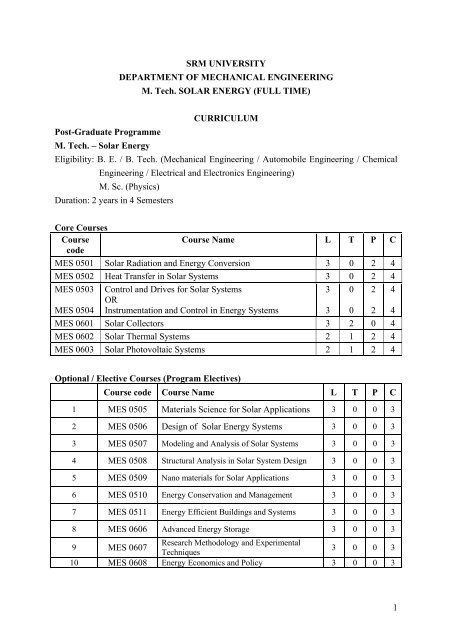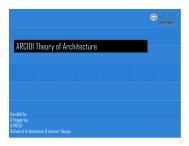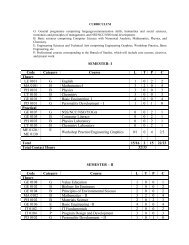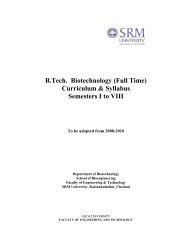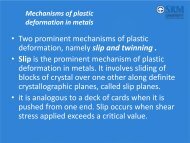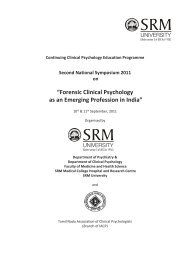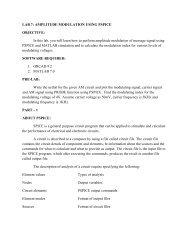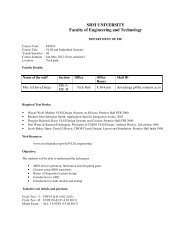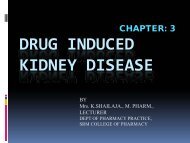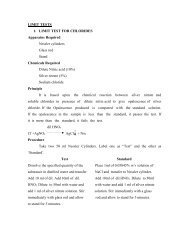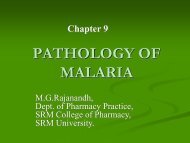SRM UNIVERSITY DEPARTMENT OF MECHANICAL ...
SRM UNIVERSITY DEPARTMENT OF MECHANICAL ...
SRM UNIVERSITY DEPARTMENT OF MECHANICAL ...
Create successful ePaper yourself
Turn your PDF publications into a flip-book with our unique Google optimized e-Paper software.
<strong>SRM</strong> <strong>UNIVERSITY</strong><br />
<strong>DEPARTMENT</strong> <strong>OF</strong> <strong>MECHANICAL</strong> ENGINEERING<br />
M. Tech. SOLAR ENERGY (FULL TIME)<br />
CURRICULUM<br />
Post-Graduate Programme<br />
M. Tech. – Solar Energy<br />
Eligibility: B. E. / B. Tech. (Mechanical Engineering / Automobile Engineering / Chemical<br />
Engineering / Electrical and Electronics Engineering)<br />
M. Sc. (Physics)<br />
Duration: 2 years in 4 Semesters<br />
Core Courses<br />
Course<br />
Course Name L T P C<br />
code<br />
MES 0501 Solar Radiation and Energy Conversion 3 0 2 4<br />
MES 0502 Heat Transfer in Solar Systems 3 0 2 4<br />
MES 0503<br />
MES 0504<br />
Control and Drives for Solar Systems<br />
OR<br />
Instrumentation and Control in Energy Systems<br />
3<br />
3<br />
0<br />
0<br />
2<br />
2<br />
4<br />
4<br />
MES 0601 Solar Collectors 3 2 0 4<br />
MES 0602 Solar Thermal Systems 2 1 2 4<br />
MES 0603 Solar Photovoltaic Systems 2 1 2 4<br />
Optional / Elective Courses (Program Electives)<br />
Course code Course Name L T P C<br />
1 MES 0505 Materials Science for Solar Applications 3 0 0 3<br />
2 MES 0506 Design of Solar Energy Systems 3 0 0 3<br />
3 MES 0507 Modeling and Analysis of Solar Systems 3 0 0 3<br />
4 MES 0508 Structural Analysis in Solar System Design 3 0 0 3<br />
5 MES 0509 Nano materials for Solar Applications 3 0 0 3<br />
6 MES 0510 Energy Conservation and Management 3 0 0 3<br />
7 MES 0511 Energy Efficient Buildings and Systems 3 0 0 3<br />
8 MES 0606 Advanced Energy Storage 3 0 0 3<br />
9 MES 0607<br />
Research Methodology and Experimental<br />
Techniques<br />
3 0 0 3<br />
10 MES 0608 Energy Economics and Policy 3 0 0 3<br />
1
11 MES 0609 Conventional and Alternative Energy Systems 3 0 0 3<br />
12 MES 0610 Computational Fluid Dynamics 3 0 0 3<br />
13 MES 0611 Indian Global Energy Scenario 3 0 0 3<br />
14 MES 0612 Environmental Impact of Energy Systems 3 0 0 3<br />
15 MES 0613 Fuel Cell and Hydrogen Technology 3 0 0 3<br />
16 MES 0614 Cogeneration and Waste Heat Recovery 3 0 0 3<br />
Supportive Courses<br />
Course code Course Name L T P C<br />
MA0551<br />
MA0507<br />
MES 0604<br />
MES 0605<br />
Other Courses<br />
Applied Mathematics for Engineers<br />
OR<br />
Computational Methods in Engineering<br />
Computer Aided Engineering Graphics (for students<br />
from Science stream)<br />
OR<br />
Optics in Solar Energy Applications (for students<br />
from Engineering stream)<br />
3 0 0 3<br />
Course code Course Name L T P C<br />
MES 0615 Seminar 0 0 2 1<br />
MES 0616 Project work Phase I 0 0 12 6<br />
MES 0617 Project work Phase II 0 0 36 18<br />
1<br />
3<br />
1<br />
0<br />
3<br />
0<br />
3<br />
3<br />
L. Lecture hours, T. Tutorial hours, P. Practical Hours, C. Credits<br />
Guidelines for choosing courses<br />
Category<br />
No of Courses<br />
I semester II semester III semester IV semester<br />
Core courses 3 3 - -<br />
Optional / Elective Courses 1 1 3 -<br />
Supportive courses 1 1 - -<br />
Seminar - - 1 -<br />
Project work Phase I - - 1 -<br />
Project work Phase II - - - 1<br />
Total number of credits to be earned for the award of degree: 70<br />
2
MES0501<br />
<strong>SRM</strong> <strong>UNIVERSITY</strong><br />
MTECH PROGRAMME IN SOLAR ENERGY<br />
SYLLABUS<br />
I CORE COURSES<br />
SOLAR RADIATION AND ITS CONVERSION<br />
L T P C<br />
3 2 0 4<br />
PURPOSE:<br />
To familiarize students with the characteristics of solar radiation, its global distribution, and<br />
conversion methods of solar energy to heat and power.<br />
INSTRUCTIONAL OBJECTIVES:<br />
Upon successful completion of the course the students will be able to understand and apply<br />
1. The characteristics and world distribution of solar radiation.<br />
2. The solar radiation measurement techniques.<br />
3. The methods of calculation of solar radiation availability at a given location.<br />
4. The fundamentals of thermodynamic and direct conversion of solar energy to power.<br />
COURSE DESCRIPTION:<br />
Sun is inexhaustible source of clean primary energy. World and India distribution of solar energy<br />
resources. Solar spectrum, extraterrestrial solar radiation, solar constant. Solar radiation on the earth<br />
surface: beam, diffuse, global. Direct normal irradiance DNI. Seasonal and daily variation. Solar<br />
radiation measurement. Earth-sun angles. Calculation of total solar radiation on horizontal and tilted<br />
surfaces. Prediction of solar radiation availability. Conversion of heat to work in thermodynamic<br />
cycles - Carnot, Rankine, Brayton. Cycle useful work output and thermal efficiency. Conversion of<br />
solar energy to electrical energy in solar thermal electric power plants. Direct conversion of solar<br />
radiation to electricity in solar cells, physics and operation of solar cells.<br />
REFERENCE BOOKS:<br />
1. Duffie J.A., Beckman W.A. Solar Engineering of Thermal Processes, 3 rd ed., Wiley, 2006.<br />
2. De Vos A. Thermodynamics of Solar Energy Conversion, Wiley-VCH, 2008.<br />
3. Garg H.P., Prakash J. Solar Energy Fundamentals and Applications, Tata McGraw-Hill, 2005.<br />
4. Kalogirou S.A. Solar Energy Engineering: Processes and Systems, Elsevier, 2009.<br />
5. Petela, R. Engineering Thermodynamics of Thermal Radiation for Solar Power, McGraw-Hill,<br />
2010.<br />
6. Harvey D.L.D. Energy and the New Reality: Carbon-Free Energy…, Earthscan, 2010.<br />
7. Foster R. et al. Solar Energy, CRC Press, 2010.<br />
8. Letcher T.M. Future Energy, Elsevier, 2008.<br />
9. Andrews J., Jelley N. Energy Science, Oxford Uni Press, 2010.<br />
MES 0502<br />
HEAT TRANSFER IN SOLAR THERMAL SYSTEMS<br />
L T P C<br />
3 0 2 4<br />
PURPOSE:<br />
To explore the fundamental principles of heat transfer processes and to understand the application of<br />
analytical, experimental and numerical methods of heat transfer to the analysis and design of solar<br />
thermal systems.<br />
INSTRUCTIONAL OBJECTIVES:<br />
Upon successful completion of the course the students will be able to understand and apply<br />
3
1. The heat transfer processes by conduction, convection and radiation.<br />
2. The calculation methods for heat exchangers used in energy systems.<br />
3. The numerical methods applied to heat transfer processes.<br />
4. The knowledge of heat transfer to analysis and design of solar thermal systems.<br />
COURSE DESCRIPTION:<br />
Heat transfer modes – conduction, convection and radiation. Thermo-physical properties of solids and<br />
fluids. One-dimensional conduction in plane wall, cylindrical and spherical walls. Heat transfer<br />
between two fluids separated by a wall, overall heat transfer coefficient. Unsteady-state conduction.<br />
Convection governing equations – laws of conservation of momentum, mass and energy. Mechanisms<br />
and empirical correlations for heat transfer calculation of forced and free convection in external and<br />
internal flow of fluids. Heat transfer with phase change – boiling, condensation. Radiation heat<br />
transfer – radiation properties, black and grey bodies, radiation laws, net energy exchange between<br />
grey bodies of simple shape. Heat exchangers – types, configurations, design calculations. Numerical<br />
methods used in heat transfer analysis and calculations. Application of the heat transfer knowledge to<br />
analysis and design of solar thermal systems and their components.<br />
REFERENCE BOOKS:<br />
1. Mills A.F., Ganesan V. Heat Transfer, 2 nd ed., Pearson, 2009.<br />
2. Minkowycz W.J., Sparrow E.M., Murthy J.Y. Handbook of Numerical Heat Transfer, 2 nd ed.,<br />
Wiley, 2006.<br />
3. Kreith F., Bohn M.S. Principles of Heat Transfer, 6 th ed., Thomson, 2001.<br />
4. Venkateshan S.P. Heat Transfer, Ane Books, 2009.<br />
5. Das S.K. Fundamentals of Heat and Mass Transfer, Narosa, 2010.<br />
6. Duffie J.A., Beckman W. A. Solar Engineering of Thermal Processes, 3 rd ed., Wiley, 2006.<br />
7. Sachdeva R.C. Fundamentals of Heat and Mass Transfer, 4 th ed., New Age, 2010.<br />
8. Ghoshdastidar P.S. Heat Transfer, Oxford Uni Press, 2004.<br />
9.<br />
MES 0503<br />
CONTROLS AND DRIVES FOR SOLAR ENERGY L T P C<br />
SYSTEMS 3 0 0 3<br />
PURPOSE:<br />
To enable the students to learn the basic concepts of Proportional Integral and Derivative controllers<br />
and different process controls involved in solar energy systems.<br />
INSTRUCTIONAL OBJECTIVES:<br />
Upon successful completion of the course the students will be able to understand and apply<br />
1. The basic control actions and characteristics of different types of controllers.<br />
2. The characteristics and mathematical modeling of final control elements.<br />
3. The operation of control systems involved in solar energy systems.<br />
4. The concept of embedded systems.<br />
COURSE DESCRIPTION:<br />
Introduction to Proportional, Integral and Derivative (PID) controllers. Characteristics - cascade and<br />
feedback - controllers design - feedback compensation. Response of controllers. Pneumatic and<br />
Electronic realization of Controllers. Selection of a controller- I/P, P/I converters. Need for process<br />
control and controller tuning. Evaluation criteria. Introduction to Matlab. Importance and types of<br />
graphical output - matrix operations, integration, solution of differential equations-Types of errorconvergence<br />
and stability-Models of mechanical systems-fluid behavior-heat transfer-solar<br />
photovoltaic cell- transient and steady state response - simulation of the model using MATLAB.<br />
Introduction and requirement of embedded system-challenges, issues and trends in embedded<br />
software development system. Design cycle in development phase. Uses of emulator and in-circuit<br />
4
emulator. Application of embedded system - control system and industrial automation, handheld<br />
computer, IVR system, and GPS receivers. Advanced control of solar plants. Basic control<br />
schematics. Basic structures of adaptive control. Model-based predictive control strategies. Frequency<br />
domain control and robust optimal control. Heuristic fuzzy logic control. Introduction to LABVIEW,<br />
current Trends in instrumentation using LABVIEW.<br />
REFERENCE BOOKS:<br />
1. Johnson G.C. et al. Control System Design, Pearson, 2003.<br />
2. Velten K. Mathematical Modeling and Simulation, Wiley-VCH, 2009.<br />
3. Camacho E.F. et al. Advanced Control of Solar Plants, Springer,1997<br />
4. Palm W.J. Introduction to MATLAB 7. 0 for Engineers, Tata McGraw-Hill, 2004<br />
5. Meyer W.J. Concepts of Mathematical Modeling, Dover Publ., 2004<br />
6. Dym C.L. Principles of Mathematical Modeling, Elsevier, 2004.<br />
MES 0504 INSTRUMENTATION AND CONTROL FOR ENERGY L TP C<br />
SYSTEMS 3 0 2 4<br />
PURPOSE:<br />
To study the types and working principle various instruments and control systems used for energy<br />
systems.<br />
INSTRUCTIONAL OBJECTIVES:<br />
Upon successful completion of the course the students will be<br />
1. Familiar with the characteristics of instruments.<br />
2. Familiar with the intelligent instruments.<br />
3. Familiar with the measurement techniques for thermo physical properties.<br />
4. Able to know the flow visualisation measurement techniques.<br />
5. Able to know the computer automated measurements and controls.<br />
COURSE DESCRIPTION:<br />
Instruments classification. Characteristics– Static and dynamic. Systematic and random<br />
errors.Statistical analysis- Uncertainty – selection and reliability. Data logging and acquisition.<br />
Measurement of temperature, pressure and flow. Intelligent instruments-physical variables-error<br />
reduction. Gas analyzers-measurement of smoke, dust and moisture, pH-gas chromatographyspectrometry.<br />
Review of basic measurement techniques. Flow visualization Techniques, shadow<br />
graph, Schileren, interferometer, LDA, heat flux measurement, Telemetry in energy systems. Digital<br />
Transducers – Interface system and Standards – Computer automated measurements and controls<br />
(CAMAC) standards – Remote monitoring and control of boiler houses – Microprocessor based<br />
temperature control system – Introduction to Microcontrollers – Process control system – Pneumatic<br />
control systems.<br />
REFERENCE BOOKS:<br />
1. Turner J., Hill M. Instrumentation for Engineers and Scientists, Oxford University Press, 2009.<br />
2. Venkateshan S.P. Mechanical Measurements, Ane Books, 2009.<br />
3. Doeblin E.O., Malik D.N. Measurement Systems, Tata McGraw-Hill, 2007.<br />
4. Ghosh M.K. Measurement and Instrumentation, Ane Books, 2010.<br />
5. Sirohi R.S., Radha Krishna H.C. Mechanical Measurements, New Age, 2007.<br />
6. Helfrick A.D., Cooper W.D. Modern Electronic Instrumentation and Measurement Techniques,<br />
PHI, 2010.<br />
7. Sumathi S., Sureka P. Virtual Instrumentation Using LABVIEW, Springer, 2007.<br />
5
MES 0601<br />
SOLAR COLLECTORS<br />
L T P C<br />
3 0 2 4<br />
PURPOSE:<br />
To familiarize the students with principle of operation, structure, testing and installation of major<br />
types of solar collectors and concentrators.<br />
INSTRUCTIONAL OBJECTIVES:<br />
Upon successful completion of the course the students will be<br />
1. Able to understand the fundamentals of non-concentrating solar collectors.<br />
2. Able to understand the principles of operation and structure of major types of concentrating solar<br />
collectors.<br />
3. Able to understand the methods of performance calculations for major collector types.<br />
4. Familiar with the techniques for testing solar collectors and concentrators.<br />
5. Familiar with the installation and operation of solar collectors and concentrators in solar thermal<br />
systems for low, middle and high temperature applications.<br />
COURSE DESCRIPTION:<br />
Fundamentals of solar collectors as devices to convert solar energy to hat. Non-concentrating low<br />
temperature flat-plate and evacuated tube collectors. Design and structures of collectors for heating<br />
liquids and air. Optimal collector tilt and orientation. Collector performance - useful energy gain,<br />
energy losses, efficiency. Use of selective coatings to enhance the collector efficiency. Concentrating<br />
collectors for middle and high temperature applications. Line-focusing and point-focusing<br />
concentrators: parabolic trough, parabolic dish, heliostat field with central receiver, Fresnel lenses,<br />
compound parabolic concentrator. Sun tracking mechanisms. Concentrating collector performance -<br />
concentration ratio, useful energy gain, energy losses, efficiency. Solar collector design, testing,<br />
installation and operation. Application of non-concentrating collectors in low temperature solar<br />
thermal plants for space heating and cooling, drying, seawater desalination. Use of concentrating<br />
collectors for process heat production and power generation.<br />
REFERENCE BOOKS:<br />
1. Duffie J.A, Beckman W.A., Solar Engineering of Thermal Process, Wiley, 3 rd ed. 2006.<br />
2. Goswami D.Y., Kreith F., Kreider J.F. Principles of Solar Engineering, 2 nd ed., Taylor and<br />
Francis, 2000, Indian reprint, 2003.<br />
3. Garg H.P., Prakash J. Solar Energy Fundamentals and Applications, Tata McGraw-Hill, 2005.<br />
4. Kalogirou S.A. Solar Energy Engineering: Processes and Systems, Academic Press, 2009.<br />
5. Chauhan D.S., Srivastava S.K. Non-Conventional Energy Resources, New Age, 2009.<br />
6. Da Rosa, A.V. Fundamentals of Renewable Energy Processes, 2 nd ed., Academic Press, 2009.<br />
MES 0602 SOLAR THERMAL SYSTEMS L T P C<br />
3 0 2 4<br />
PURPOSE:<br />
To learn fundamentals and application of solar thermal systems for heating, cooling, power generation<br />
and other applications. This course is designed to provide the knowledge about solar thermal energy<br />
technology.<br />
INSTRUCTIONAL OBJECTIVES:<br />
Upon successful completion of the course the students will be able to understand and apply<br />
1. The basic knowledge on solar thermal technology for water and space heating and cooling,<br />
2. The basics of solar thermal technology for power generation and process heat production.<br />
3. The functioning of main and auxiliary components of solar thermal systems.<br />
4. The fundamentals of design calculations and analysis of solar thermal systems.<br />
6
COURSE DESCRIPTION:<br />
Active and passive low temperature solar thermal systems. Solar water heaters with natural and pump<br />
circulation. Components: flat-plate or evacuated tube collectors, energy storage, auxiliaries. Solar<br />
water heater performance, efficiency. Solar space heating systems. Thermal energy storage systems:<br />
sensible and latent heat storage. Solar vapor absorption refrigeration and space cooling. Solar<br />
cooking, seawater desalination, solar pond, solar greenhouse. Solar systems for process heat<br />
production and power generation. Types of solar thermal electric power plants based on parabolic<br />
trough, solar tower (central receiver), parabolic dish/Stirling engine. Concentrated solar power using<br />
Fresnel lenses. Fundamentals of design calculations and analysis of solar thermal systems. Solar plant<br />
installation, economics.<br />
REFERENCE BOOKS:<br />
1. Kalogirou S.A. Solar Energy Engineering: Processes and Systems, Academic Press, 2009.<br />
2. Vogel W., Kalb H. Large-Scale Solar Thermal Power Technologies, Wiley-VCH, 2010.<br />
3. Duffie J. A, Beckman W . A., Solar Engineering of Thermal Process, Wiley, 3 rd ed. 2006.<br />
4. Khartchenko N.V. Green Power: Eco-Friendly Energy Engineering, Tech Books, Delhi, 2004.<br />
5. Andrews J., Jelley N. Energy Science, Oxford Uni Press, 2010.<br />
6. Chauhan D.S., Srivastava S.K. Non-Conventional Energy Resources, New Age, 2009.<br />
7. Goswami D.Y., Kreith F., Kreider J.F. Principles of Solar Engineering, 2 nd ed., Taylor and<br />
Francis, 2000, Indian reprint, 2003.<br />
8. Garg H.P., Prakash J. Solar Energy Fundamentals and Applications, Tata McGraw-Hill, 2005.<br />
9. Laughton C. Solar Domestic Water Heating, Earthscan, 2010.<br />
10. Yannas S. et al. Roof Cooling Techniques: Design Handbook, Earthscan, 2006.<br />
MES 0603 SOLAR PHOTOVOLTAIC TECHNOLOGY L T P C<br />
3 2 0 4<br />
PURPOSE:<br />
To learn the fundamentals, design and application of solar photovoltaic systems for power generation<br />
on small and large scale for rural and urban electrification.<br />
INSTRUCTIONAL OBJECTIVES:<br />
Upon successful completion of the course the students will be able to understand and apply<br />
1. The principle of direct solar energy conversion to power using PV technology.<br />
2. The structure, materials and operation of solar cells, PV modules, and arrays.<br />
3. The socio-economic and environmental merits of photovoltaic systems for a variety of<br />
applications.<br />
4. The prospects of photovoltaic technology for sustainable power generation.<br />
COURSE DESCRIPTION:<br />
Photovoltaic effect - principle of direct solar energy conversion into electricity in a solar cell.<br />
Semiconductor properties, energy levels, basic equations. Solar cell, p-n junction, structure.<br />
Crystalline silicon cells, multiple-junction solar cells. Crystalline silicon modules, thin-film modules.<br />
PV module performance - I-V characteristics of a PV module, MPP, efficiency, fill factor, effect of<br />
irradiation and temperature. Concentrator photovoltaics. Design of PV systems. PV system<br />
applications: building-integrated photovoltaic units, grid-interacting central power stations, standalone<br />
devices for distributed power supply in remote and rural areas, solar cars, aircraft, space solar<br />
power satellites. System components: PV arrays, inverters, batteries, charge controls, net power<br />
meters. PV array installation, operation, costs, reliability. Socio-economic and environmental merits<br />
of photovoltaic systems.<br />
7
REFERENCE BOOKS:<br />
1. Messenger R.A., Ventre J. Photovoltaic Systems Engineering, 3rd ed., CRC Press, 2010.<br />
2. Petrova-Koch V. et al. Highly-Efficient Low-Cost Photovoltaics, Springer, 2009.<br />
3. Luque A.L.and Andreev V.M., eds. Concentrator Photovoltaics, Springer, 2007.<br />
4. Hankins M. Stand-Alone Solar Electric Systems, Earthscan, 2010.<br />
5. Electricity from Renewable Resources: Status, Prospects, and Impediments. Washington,<br />
National Academies Press, 2010.<br />
6. Planning and Installing Photovoltaic Systems: Guide for Installers, Architects and Engineers, 2 nd<br />
ed., Earthscan, 2008.<br />
7. Jha A.R. Solar Cell Technology and Applications, CRC Press, 2010.<br />
8. Partain L.D., Fraas L.M. Solar Cells and Their Applications, 2 nd ed., Wiley, 2010.<br />
9. Reddy P.J. Science and Technology of Photovoltaics, 2 nd ed., CRC Press, 2010.<br />
10. Boxwell M. Solar Electricity Handbook, Greenstream Publ., 2010.<br />
11. Luque A.L., ed. Handbook of Photovoltaic Science and Engineering, Wiley, 2003.<br />
III OPTIONAL / ELECTIVE COURSES<br />
MES 0505<br />
MATERIALS SCIENCE FOR SOLAR ENERGY<br />
APPLICATIONS<br />
L T P C<br />
3 0 0 3<br />
PURPOSE:<br />
This course provides the basic knowledge of modern materials science and engineering with<br />
application to solar energy systems.<br />
INSTRUCTIONAL OBJECTIVES:<br />
Upon successful completion of the course the students will be able to understand and apply<br />
1. The basics of materials science and engineering.<br />
2. The properties of various materials and special coatings, and their application.<br />
3. The testing of materials behavior suitable for application in solar energy systems.<br />
4. The environmental impact on solar system materials and their corrosion protection.<br />
COURSE DESCRIPTION:<br />
Fundamental principles of materials science: electronic and atomic structures, atomic bonding in<br />
solids, crystal structure, microstructure, solidification, alloys. Mechanical, photonic, thermal,<br />
electrical and magnetic properties of metals, alloys, semiconductors, polymers, glass, composites,<br />
nanomaterials and magnetic materials. Elasticity in metals and polymers, plastic deformation, yield<br />
stress, shear strength, strengthening mechanisms, effect of temperature, fracture behavior of various<br />
materials, failure analysis, solid solutions, phase diagrams, definition of structures. Basics of strength<br />
of materials. Concepts of stress and strain. Hooke's law. Tension, compression, and shear, stress-strain<br />
diagram. Thermal stresses. Materials for components of solar thermal and photovoltaic systems: solar<br />
collectors, special coatings, reflectors, lenses, receivers, thermal energy storage, heat exchangers,<br />
solar cells, modules, batteries, inverters, charge controls, supporting structures. Wind load on<br />
structures and solar system components - collector fields, photovoltaic arrays. Environmental effects –<br />
weathering and corrosion testing of materials in solar systems.<br />
REFERENCE BOOKS:<br />
1. Callister W.D. Materials Science and Engineering an Introduction, 6 th ed., Wiley, 2004.<br />
2. Raghavan V. Materials Science and Engineering, Prentice-Hall India, 2007.<br />
3. Ramamrutam S. Strength of Materials, 16 th ed., Danpat Rai Publ., 2010.<br />
4. Callister W.D. Materials Science and Engineering, 6 th ed., Wiley India, 2009<br />
5. Sheckelford J.F., Muralidham M.K. Intro to Materials Science for Engineers, 6 th ed., Pearson,<br />
2007.<br />
6. Askeland D.R. Science and Engineering of Materials, 4 th ed., Tomson, 2003.<br />
7. Balasubramaniam R. Callister's Materials Science and Engineering, Wiley India, 2007.<br />
8
MES 0506<br />
DESIGN <strong>OF</strong> SOLAR ENERGY SYSTEMS<br />
L T P C<br />
3 0 0 3<br />
PURPOSE:<br />
To familiarize the students with design methods suitable for solar thermal and photovoltaic systems.<br />
INSTRUCTIONAL OBJECTIVES:<br />
Upon successful completion of the course the students will be able<br />
1. To express ideas in sketches, interpret and create engineering drawings,<br />
2. To model the processes, perform design calculations, using software, select components and<br />
choose materials,<br />
3. To develop competence skills and self-confidence as design engineers,<br />
4. To complete projects on schedule and within budget.<br />
COURSE DESCRIPTION:<br />
This course emphasizes the creativity of the design process and systems approach to the design. It<br />
includes system conceptual design, design of major components and overall system design based on<br />
application of physical principles to the solar system design.. The process includes idea generation,<br />
concept selection and estimation, design of major components, and overall system design. Solar<br />
radiation data. Design of solar thermal systems for water and space heating and cooling, power<br />
generation. f-Chart calculation method for sizing solar water and space heating systems. Design of<br />
non-focusing and focusing collectors, heat storage. Design of photovoltaic off-grid and gridconnected<br />
power systems incl. system components - PV modules, batteries, charge controllers,<br />
inverters, auxiliaries. Performance analysis of a photovoltaic system, estimation of its economics.<br />
Using software codes for design of solar thermal and photovoltaic systems. Application examples.<br />
REFERENCE BOOKS:<br />
1. Duffie J.A. and Beckman W.A. Solar Engineering of Thermal Process, Wiley, 3 rd ed., 2006.<br />
2. Da Rosa A.V. Fundamentals of Renewable Energy Processes, 2 nd ed., Academic Press, 2009.<br />
3. Kalogirou S.A. Solar Energy Engineering: Processes and Systems, Academic Press, 2009.<br />
4. Sen Z. Solar Energy Fundamentals and Modeling Techniques, Turkey, 2008<br />
5. Vogel W., Kalb H. Large-Scale Solar Thermal Power Technologies, Wiley-VCH, 2010.<br />
6. Dincer I., Rosen M. Thermal Energy Storage, 2nd ed., Wiley, 201<br />
7. Prasad D., & Snow, M., eds. Designing with Solar Power, Earthscan, 2005.<br />
MES 0507 MODELING AND ANALYSIS <strong>OF</strong> SOLAR SYSTEMS L T P C<br />
3 0 0 3<br />
PURPOSE:<br />
To familiarize the students with methods of modeling and analysis of solar thermal and PV systems.<br />
INSTRUCTIONAL OBJECTIVES:<br />
Upon successful completion of the course the students will be able to understand and apply<br />
1. the analysis techniques for solar thermal systems,<br />
2. the analysis techniques for photovoltaic systems,<br />
3. the software for modeling and design of solar thermal systems and their components,<br />
4. the software for modeling and design of photovoltaic systems and their components.<br />
9
COURSE DESCRIPTION:<br />
This course presents fundamental knowledge and tools related to modeling and analysis of solar<br />
energy systems. Modeling overview - levels of analysis, steps in model development, examples of<br />
models. Quantitative techniques: interpolation. polynomial, lagrangian, curve fitting, regression<br />
analysis, solution of transcendental equations. Numerical solution of differential equations- overview,<br />
convergence, accuracy. Introduction to the methodology of the system modeling, analysis, simulation<br />
and economic assessment. Overview of effective tools for solar energy systems: RETScreen - to<br />
evaluate the energy production and savings of various types of renewable energy and energy efficient<br />
technologies, TRNSYS used for dynamic simulation of solar heating and cooling systems,<br />
GREENIUS - for simulation, design and analysis of solar thermal electric and photovoltaic systems,<br />
PVSYST - for sizing, simulation and analysis of photovoltaic systems. Case studies of energy system<br />
optimization. Application: analysis and design of solar thermal and photovoltaic systems.<br />
REFERENCE BOOKS:<br />
1. Bender E.A. Introduction to Mathematical Modeling, Dover Publ., 2000.<br />
2. Meyer W.J. Concepts of Mathematical Modeling, Dover Publ., 2004.<br />
3. Dym C.L. Principles of Mathematical Modeling, Elsevier, 2004.<br />
4. Duffie J.A., Beckman W.A. Solar Engineering of Thermal Process, Wiley, 3 rd ed. 2006.<br />
5. Kalogirou S.A. Solar Energy Engineering: Processes and Systems, Academic Press, 2009.<br />
6. Sen Z. Solar Energy Fundamentals and Modeling Techniques, Turkey, 2008.<br />
7. Vanek F.M., Albright L.D. Energy Systems Engineering, McGraw-Hill, 2008.<br />
MES 0508<br />
STRUCTURAL ANALYSIS IN SOLAR SYSTEM DESIGN<br />
L T P C<br />
3 2 0 4<br />
PURPOSE:<br />
To study the principles of structural analysis and its application to solar energy system structures.<br />
INSTRUCTIONAL OBJECTIVES:<br />
Upon successful completion of the course the students will be<br />
1. familiar with the concepts and principles of structural analysis,<br />
2. able to apply the structural analysis in solar energy system structure design,<br />
3. able to perform the wind load calculation for solar energy system structures.<br />
COURSE DESCRIPTION:<br />
Concepts and principles of strength of materials: stress and strain, tension, compression, stress-strain<br />
diagram. Thermal stresses. Principal plane, principal stress, maximum shearing stress. Cylinders and<br />
spherical shells. Principles of structural analysis. Types of structures and loads. Normal force, shear<br />
force, bending moment and torsion. Analysis of pin-jointed trusses, cables, arches. Bending, shear,<br />
torsion of beams. Composite beams. Deflection of beams. Complex stress and strain. Analysis of<br />
statically determinate structures. Principle of superposition. Determinacy and stability. Analysis of<br />
simple diaphragm and shear wall systems. Analysis of statically indeterminate structures. Influence<br />
lines. Structural instability. Approximate analysis of statically indeterminate structures. Vertical and<br />
lateral loads on building frames. External work and strain energy. Force method of analysis: frames,<br />
trusses, composite structures. Displacement method of analysis: beams, frames. moment distribution<br />
for beams, frames. Fundamentals of the stiffness method. Matrix analysis of trusses, beams and<br />
frames by the direct stiffness method. Wind loads. Wind load on building structures. Wind load on<br />
solar collectors and PV panels mounted on the roof. Barriers: varieties of materials and air barrier<br />
configuration.<br />
REFERENCE BOOKS:<br />
1. Hibbeler R.C. Structural Analysis, 7th ed., Prentice Hall, 2009.<br />
10
2. Ramamrutam S. Strength of Materials, 16 th ed., Danpat Rai Publ., 2010.<br />
3. McCormac J.C. Structural Analysis: Classical and Matrix Methods, 4th ed., Wiley, 2007.<br />
4. Leet K. et al. Fundamentals of Structural Analysis, 3rd ed., McGraw-Hill, 2008.<br />
5. Al Nageim H. et al. Structural Mechanics: Loads, Analysis, Design and Materials, 7th ed.,<br />
Prentice Hall/Pearson, 2010.<br />
6. Bangash M.Y.H. Shock, Impact and Explosion: Structural Analysis and Design, Springer, 2009.<br />
7. Rajan S.D. Introduction to Structural Analysis and Design, 2001.<br />
8. Dyrbye C. Wind Loads on Structures, 3rd ed., Wiley, 1997.<br />
MES 0509<br />
NANOMATERIALS FOR SOLAR ENERGY APPLICATIONS<br />
L T P C<br />
3 0 0 3<br />
PURPOSE:<br />
To study the nanotechnology applications in solar energy engineering.<br />
INSTRUCTIONAL OBJECTIVES:<br />
Upon successful completion of the course the students will be familiar with<br />
1. the nanostructures and nanomaterials and their properties,<br />
2. the use of nanostructures and nanomaterials in solar energy conversion devices and systems,<br />
3. the use of nanostructures and nanomaterials in solar energy storage,<br />
4. the use of nanostructures and nanomaterials in the fuel cell and hydrogen technology.<br />
COURSE DESCRIPTION:<br />
Nanotechnology in energy production. Conversion of thermal energy to electrical energy using<br />
nanostructures and nanomaterials. Materials selection criteria, particle-scale effect. Phase<br />
compositions on nanoscale microstructures. Thermal and thermoelectric properties of nanostructures -<br />
modeling and metrology. Nanowires, nanostructures, nanocomposites. Use of nanostructures and<br />
nanomaterials in solar technology for energy conversion. Photochemical solar cells, PV panels with<br />
nanostructures. Nanostructures and nanomaterials utilization in solar energy storage systems. Use of<br />
nanostructures and nanomaterials in fuel cell technology. High and low temperature fuel cells,<br />
cathode and anode reactions, fuel cell catalysts, electrolytes, ceramic catalysts. Use of nanotechnology<br />
in hydrogen production and storage. Nanotechnology for electrochemical energy storage.<br />
REFERENCE BOOKS:<br />
1. Garcia-Martinez J., ed. Nanotechnology for Energy Challenge, Wiley-VCH, Weinheim, 2010.<br />
2. Wiesner M.R. and Bottero J.-Y. Environmental Nanotechnology: Applications and Impacts of<br />
Nanomaterials, Tata McGraw-Hill, 2007.<br />
3. Karkare I.K. Nanotechnology - Fundamentals and Applications, IK Intern. Publ., 2008.<br />
4. Maheshwar Sharon, Madhuri Sharon. Carbon Nanoforms and Applications, McGraw-Hill,<br />
2010.<br />
5. Leite E.R. Nanostructured Materials for Electrochemical Energy Production and Storage,<br />
Springer, 2009.<br />
6. Eftekhari A. Nanostructured Materials in Electrochemistry, Wiley-VCH, 2008.<br />
7. Tsakalakos L. Nanotechnology for Photovoltaics, CRC, 2010.<br />
8. Vayssieres L. On Solar Hydrogen and Nanotechnology, Wiley, 2009.<br />
9. Allhoff F. et al. What is Nanotechnology…Wiley, 2010.<br />
MES 0510<br />
ENERGY CONSERVATION AND MANAGEMENT<br />
L T P C<br />
3 0 0 3<br />
PURPOSE:<br />
To familiarize the students with energy conservation and management.<br />
11
INSTRUCTIONAL OBJECTIVES:<br />
Upon successful completion of the course the students will be able to understand and apply<br />
1. The techniques for solving practical problems related to thermal energy conservation,<br />
2. The techniques for solving practical problems related to electrical energy conservation,<br />
3. The concepts and techniques of energy management,<br />
4. The energy management methods for conducting audits and achieving energy savings.<br />
COURSE DESCRIPTION:<br />
Energy conservation - basic concepts and principles. Energy conservation in buildings, industry,<br />
transport. Energy efficient heating and cooling systems. Energy conservation in HVAC. Energy<br />
conservation through application of thermal insulation and efficient controls. Maintenance<br />
engineering. Energy efficient lighting, energy efficient motors. Building energy management. Tariffs<br />
and power factor improvement. Energy management concepts, energy demand, energy supply,<br />
economic analysis. Duties and responsibilities of energy managers. Electrical and thermal energy<br />
management, supply side. Methods to minimize energy supply-demand gap. Modernization of<br />
thermal power plants. Demand side energy management. Energy conservation in boilers, steam<br />
turbines and industrial heating systems, auxiliaries (motors, pumps, fans etc.). Cogeneration systems.<br />
Waste heat recovery. Use of heat exchangers and heat pumps.<br />
REFERENCE BOOKS:<br />
1. Kreith F., Goswami D.Y. Energy Management and Conservation Handbook, Taylor & Francis,<br />
2008.<br />
2. Jayamaha L. Energy-Efficient Building Systems, McGraw-Hill, 2007.<br />
3. Russell C. Managing Energy from the Top Down, Fairmount Press, 2010.<br />
4. Neelameggham N.R. et al. Energy Technology 2010: Conservation, Wiley-VCH, 2010.<br />
5. Energy Efficiency in Buildings: CIBSE Guide, 2nd ed., CIBSE, 2004.<br />
6. CIPEC, Energy Savings Toolbox, Natural Resources Canada, 2007.<br />
7. Wulfinghoff D.R. Energy Efficiency Manual, Energy Inst. Press, 2003.<br />
8. Neelameggham N.R. et al. Energy Technology 2010: Conservation, Wiley-VCH, 2010.<br />
MES 0511<br />
ENERGY EFFICIENT BUILDINGS AND SYSTEMS<br />
L T P C<br />
3 0 0 3<br />
PURPOSE:<br />
This course provides an introduction to the energy efficient building design, construction, operation<br />
and it economics<br />
INSTRUCTIONAL OBJECTIVES:<br />
Upon successful completion of the course the students will be able to understand and apply<br />
1. The concepts and techniques of energy efficient buildings and solar house design features,<br />
2. The concepts and techniques of solar passive heating and cooling systems,<br />
3. The integration of active solar thermal elements and PV modules in the building envelope,<br />
4. The principles, materials, systems and construction techniques to create energy efficient and green<br />
buildings with utilization solar energy.<br />
COURSE DESCRIPTION:<br />
Concepts of energy efficient buildings and energy efficient HVAC systems. Calculation of heating<br />
and cooling loads of the building. Building’s energy balance accounting for solar energy gain, heat<br />
losses, internal heat sources. Passive solar design for heating and cooling, solar house.<br />
Passive heating techniques: direct solar heat gain, Trombe wall, sun space. Potential for energy<br />
savings through proper design and use of renewable energy sources. Low energy and zero energy<br />
buildings. Design of passive solar heating systems. Passive building cooling techniques: natural<br />
ventilation, evaporative cooling, reradiation. Sizing windows, thermal mass, thermal insulation.<br />
12
Integration of active solar thermal elements and PV modules in the building envelope. Combination of<br />
a solar system, heat pump, and waste heat recovery system.<br />
Green building features: green materials, integrated ecological design, sustainable site and<br />
landscaping enhancing ecosystems, indoor environment quality, microclimate, daylighting, water and<br />
waste management. Costs and benefits relevance to LEED / IGBC standards. High-performance green<br />
buildings, economics. managing initial costs, environment benefits. International green globes<br />
building assessment system.<br />
REFERENCE BOOKS:<br />
1. Means R.S. Green building: project planning and cost estimating. Kingston, Mass., 2006.<br />
2. Kibert C.J. Sustainable Construction: Green Building Design…, 2 nd ed., Wiley, 2007.<br />
3. Boecker J. et al. Integrative Design Guide to Green Building, Wiley, 2009.<br />
4. Energy Efficiency in Buildings: CIBSE Guide, 2 nd ed., CIBSE, 2004.<br />
5. Prasad D., Snow M., eds. Designing with Solar Power, Earthscan, 2005.<br />
6. Eicker U. Low Energy Cooling for Sustainable Buildings, Wiley, 2009.<br />
7. Gevorkian P. Alternative Energy Systems in Building Design, McGraw-Hill, 2010.<br />
8. Attmann O. Green Architecture, McGraw-Hill, 2010.<br />
9. Hyde R., ed. Bioclimatic Housing: Innovative Designs for Warm Climates, Earthscan, 2008.<br />
10. Harvey D.L. Handbook on Low-Energy Buildings and District-Energy Systems, Earthscan, 2006.<br />
11. Neelameggham N.R. et al. Energy Technology: Conservation, Wiley-VCH, 2010.<br />
12. ECBC 2007 Manual, Bureau of Energy Efficiency, New Delhi, 2007.<br />
13. Galloway T. Solar House: Guide for the Solar Designer, Oxford : Architectural Press, 2004.<br />
MES 0606<br />
ADVANCED ENERGY STORAGE<br />
L T P C<br />
3 0 0 3<br />
PURPOSE:<br />
To study the fundamentals and application of advanced energy storage systems for solar thermal and<br />
photovoltaic systems.<br />
INSTRUCTIONAL OBJECTIVES:<br />
Upon successful completion of the course the students will be able to understand and apply<br />
1. the concepts and techniques of advanced thermal storage systems (TES),<br />
2. the design and analysis techniques used for various sensible heat storage types,<br />
3. the concepts and designs of TES units using PCM materials,<br />
4. the techniques used for storing mechanical and electrical energy.<br />
COURSE DESCRIPTION:<br />
Basics of energy storage: necessity, utilization of energy storage devices, specific areas of<br />
applications of energy storage, selection of types of energy to be stored, types of storage system.<br />
Thermal storage systems (TES): types - sensible heat storage, latent heat storage. TES system<br />
selection criteria. Latent heat storage types, properties of phase change materials. TES system<br />
selection for solar water and space heating applications. Cold storage technologY for process cooling<br />
and building air conditioning systems. Thermo-chemical energy storage and transport. Storage of<br />
mechanical and electrical storage. Flywheel, pumped hydro, compressed air energy storage (CAES),<br />
electro-chemical energy, magnetic energy, hydrogen energy. Energy storage for photovoltaic systems.<br />
Application of nanostructured materials for energy production and storage.<br />
REFERENCE BOOKS:<br />
1. Dincer I., Rosen M. Thermal Energy Storage, 2 nd ed., Wiley, 2010.<br />
2. Crabtree R.H. Energy Production and Storage, Wiley-VCH, 2010.<br />
13
3. Leite E.R. Nanostructured Materials for Electrochemical Energy Production and Storage,<br />
Springer, 2009.<br />
4. Zito R. Energy Storage, Wiley, 2010.<br />
5. Duffie J.A, Beckman W.A., Solar Engineering of Thermal Process, Wiley, 3 rd ed. 2006.<br />
6. Garg H.P., Prakash J. Solar Energy Fundamentals and Applications, Tata McGraw-Hill, 2005.<br />
7. Kalogirou S.A. Solar Energy Engineering: Processes and Systems, Academic Press, 2009.<br />
MES<br />
0607<br />
RESEARCH METHODOLOGY AND EXPERIMENTAL L T P C<br />
TECHNIQUES 3 0 0 3<br />
PURPOSE:<br />
To study the various research methodologies, data collection methods, sampling methods, analysis<br />
and report writing.<br />
INSTRUCTIONAL OBJECTIVES:<br />
Upon successful completion of the course the students will be able to understand and apply<br />
1. The research methodologies,<br />
2. The data collection methods,<br />
3. The sampling methods, sample test and analysis,<br />
4. The methodology of report writing.<br />
COURSE DESCRIPTION:<br />
Research methodology - definition, mathematical tools for analysis. Types of research, exploratory<br />
research, conclusive research, modeling research, algorithmic research. Research process steps. Data<br />
collection method. Primary data - observation method, personal interview, telephonic interview, mail<br />
survey, questionnaire design. Secondary data- internal sources of data, external sources of data.<br />
Scales, measurement, types of scale. Sampling methods. Probability sampling methods, simple<br />
random sampling with and without replacement, stratified sampling, cluster sampling. Nonprobability<br />
sampling method, convenience sampling, judgment sampling, quota sampling. Hypotheses<br />
testing, Testing of hypotheses concerning means (one mean and difference between two means - one<br />
tailed and two tailed tests), concerning variance - one tailed Chi-square test, Nonparametric tests, One<br />
sample tests, one sample sign test, Kolmogorov-Smirnov test, run test for randomness, Two sample<br />
tests,Two sample sign test, Mann-Whitney U test, K-sample test - Kruskal Wallis test (H-Test) -<br />
Introduction to Discriminant analysis, Factor analysis, cluster analysis, multidimensional scaling,<br />
conjoint analysis. Report writing, types of reports, Guidelines to review report, typing instructions,<br />
oral presentation.<br />
REFERENCE BOOKS:<br />
1. Colwell R., ed. MENC Handbook of Research Methodologies, Oxford University Press, 2006.<br />
2. Welman, J.C. et al. Research methodology, 3rd ed., Oxford University Press, 2005.<br />
3. Panneerselvam R. Research Methodology, Prentice-Hall India, New Delhi, 2004.<br />
4. Marczyk, G. et al. Essentials of research design and methodology, Wiley, 2005.<br />
MES 0608<br />
ENERGY ECONOMICS AND POLICY<br />
L T P C<br />
3 0 0 3<br />
PURPOSE:<br />
To make students competent in the areas of energy economics and policy, and energy auditing.<br />
INSTRUCTIONAL OBJECTIVES:<br />
Upon successful completion of the course the students will be able to understand and apply<br />
1. the basics of energy economics and policy,<br />
14
2. the energy auditing techniques for different case studies,<br />
3. the energy management techniques to solving practical problems,<br />
4. the concepts and methods of energy economics to solar energy systems.<br />
COURSE DESCRIPTION:<br />
This course includes different measures of financial and economic performance and their relative<br />
merits and limitations specifically for solar energy projects, the time value of money and derivation of<br />
relevant formulae including B/C ratios, discount rate, standard and discount payback period,<br />
depreciation, and net present benefit. Also studied are approaches for considering uncertainty,<br />
financial incentives, various methods for financing solar energy projects, regulations, legislation,<br />
cultural aspects, maintenance, insurance issues, and subsidy programs. Elements of economic<br />
principles, economic calculation. Energy economics - basic concepts, unit cost of power generation<br />
from different sources, payback period, NPV, IRR, and benefit-cost analysis. Conventional and<br />
renewable (solar) energy resources and costs. Direct and indirect costs, pricing system. Project<br />
management. Energy policy. Energy technology development priorities: significance of renewable<br />
(solar) energy sources for sustainable economic development. Economics of solar energy systems.<br />
Increase in value creation. Funding and sponsoring facilities, international organizations, national<br />
possibilities. Incentives, subsidies, feed-in tariffs, carbon credits. Energy needs for economical growth<br />
and national development. Socio-economics, basic needs, ethics. Ecological issues, sustainable energy<br />
future. Energy auditing and management. Conservation of thermal and electrical energy in buildings<br />
and various industries.<br />
REFERENCE BOOKS:<br />
1. Kreith F., Goswami D.Y. Energy Management and Conservation Handbook, Taylor and Francis,<br />
2008.<br />
2. Aswathanarayana U. Green Energy: Technology, Economics and Policy, CRC Press, 2010.<br />
3. CIPEC. Energy Savings Toolbox, Natural Resources Canada, 2007.<br />
4. Russell, C. Managing Energy from the Top Down, Fairmount Press, 2010.<br />
5. Mallon K. Renewable Energy Policy and Politics, Earthscan, 2006.<br />
6. Danny Harvey L.D. Energy and the New Reality 2: Carbon-Free Energy, Earthscan, 2010.<br />
MES 0609<br />
CONVENTIONAL AND ALTERNATIVE ENERGY SYSTEMS<br />
L T P C<br />
3 0 0 3<br />
PURPOSE:<br />
This course deals with energy sources and resources, principles of operation, design, environmental<br />
aspects and economics of state-of-art conventional (fossil fuel fired power plants incl. steam power<br />
plants, supercritical and ultra-supercritical steam power plants, gas turbine power plants, combined<br />
cycle power plants, cogeneration (CHP) plants, renewable and nuclear energy power generation<br />
technologies.<br />
INSTRUCTIONAL OBJECTIVES:<br />
Upon successful completion of the course the students will be able to understand and apply<br />
1. The knowledge about energy sources, energy resources and energy conversion methods,<br />
2. The advanced conventional power generation technology and development trend,<br />
3. The alternative power generation technologies,<br />
4. The criteria for comparison of conventional and alternative energy technologies,<br />
5. The issues of energy system economics and environmental impact.<br />
15
COURSE DESCRIPTION:<br />
Principle of energy conversion. Conventional power generation technology. Steam power plants -<br />
performance enhancement techniques, advanced technologies for coal-fired power plants,<br />
supercritical and ultra-supercritical steam power plants, power plant major and auxiliary equipment.<br />
Flue gas clean-up systems for removal of particulates, sulfur and nitrogen oxides. Clean coal<br />
technology with CO2-sequestration. Gas turbine power plants - performance enhancement techniques,<br />
equipment. Combined cycle power pants (CCPP), integrated gasification combined cycle (IGCC) -<br />
equipment, performance. Cogeneration (CHP) plants - equipment, performance. CCPP and CHP<br />
advantages, design examples. Renewable energy (REN) technologies for power generation. Solar<br />
thermal electric and PV technologies. Wind power plants. Hydro-electric, geothermal, ocean, tidal<br />
technologies. Biomass cogeneration plants. Merits, limitations and challenges of REN technologies.<br />
Basics of nuclear power generation: reactors, fuel life cycle, design, security and safety. Performance<br />
comparison of conventional, renewable and nuclear power plants. Economics and environmental<br />
impact criteria.<br />
REFERENCE BOOKS:<br />
1. Khartchenko N.V. Advanced Energy Systems, Taylor and Francis, Washington DC, 1998.<br />
2. Chauhan D.S., Srivastava S.K. Non-Conventional Energy Resources, New Age, 2009.<br />
3. Georgiadis M.C. et al. Energy Systems Engineering, Wiley-VCH, 2008.<br />
4. Rajput R.K. Power Plant Engineering, 4 th ed., Laxmi Publ., 2008.<br />
5. Kalogirou S.A. Solar Energy Engineering: Processes and Systems, Academic Press, 2009.<br />
6. Vogel W., Kalb H. Large-Scale Solar Thermal Power Technologies, Wiley-VCH, 2010.<br />
7. Hodge B.K. Alternative Energy Systems, Wiley, 2009.<br />
8. Khartchenko N.V. Green Power: Eco-Friendly Energy Engineering, Tech Books, New Delhi,<br />
2004.<br />
9. Gevorkian P. Alternative Energy Systems in Building Design, McGraw-Hill, 2010.<br />
10. Vanek F.M., Albright L.D. Energy Systems Engineering, McGraw-Hill, 2008.<br />
11. Farret F.A. et al. Integration of Alternative Sources of Energy, Wiley, 2006.<br />
MES 0610 COMPUTATIONAL FLUID DYNAMICS<br />
L T P C<br />
3 0 0 3<br />
PURPOSE:<br />
To study the principles and applications of Computational Fluid Dynamics<br />
INSTRUCTIONAL OBJECTIVES:<br />
Upon successful completion of the course the students will be able to understand and apply<br />
1. the governing equations of CFD and the finite elements method,<br />
2. the finite volume formulations applicable to flow problems,<br />
3. the finite difference method for solving heat transfer problems,<br />
5. the grid generation techniques for solving flow problems.<br />
COURSE DESCRIPTION:<br />
Governing equations, classification, initial and boundary conditions, boundary (BC) value problem.<br />
Laws of conservation of momentum and energy. Solution methods - finite volume formulation, finite<br />
elements method (FEM), 1D, 2D and 3D problems. Shape function, BC handling in FEM. Laplace<br />
equation, Poisson equation, parabolic equations. Potential flow - stream and vorticity function.<br />
SIMPLE algorithm, PISO algorithm. Prandtl mixing length model, one equation model, K-ε model,<br />
RSM equation model. Structural grid generation, algebraic methods, PDE mapping methods.<br />
Unstructural grid generation using Delaugny-Voronoi method, adaptive method, mesh refinement<br />
method, mesh mover methods.<br />
16
REFERENCE BOOKS:<br />
1. Zikanov O. Essential Computational Fluid Dynamics, Wiley, 2010.<br />
2. Chung T.J. Computational Fluid Dynamics, Cambridge University Press, 2003.<br />
3. Hirsch C. Numerical Computation of Internal and External Flows, Elsevier, 2007.<br />
4. Date A.W. Introduction to Computational Fluid Dynamics, Cambridge University, 2005.<br />
5. Bates P.D, ed. Computational Fluid Dynamics, Wiley, 2005.<br />
6. Minkowycz W.J. et al. Handbook of Numerical Heat Transfer, 2 nd ed., Wiley, 2006.<br />
7. Ghoshdastidar P. S. Computer Simulation of Flow and Heat Transfer, Tata McGraw-Hill, 1998.<br />
MES 0611<br />
INDIAN AND GLOBAL ENERGY SCENARIO L T P C<br />
3 0 0 3<br />
PURPOSE:<br />
To familiarize the students in the area of Indian and Global energy scenario.<br />
INSTRUCTIONAL OBJECTIVES:<br />
Upon successful completion of the course the students will be able to identify the types of<br />
energy resources, their consumption pattern, their demand and the need for the alternate<br />
source of energy..<br />
COURSE DESCRIPTION:<br />
Energy resources & Consumption-Commercial and noncommercial forms of energy, Fossil<br />
fuels, Renewable sources including Biofuels in India, their utilization pattern in the past,<br />
present and future projections of consumption pattern, Sector wise energy consumption..<br />
Impact of Energy on Economy, Development and Environment, Energy for Sustainable<br />
development, Energy and Environmental policies, Need for use of new and renewable energy<br />
sources. Future Energy Options-Sustainable Development, Energy Crisis, Transition from<br />
carbon rich and nuclear to carbon free technologies, parameters of transition. Energy Policy<br />
Issues- Fossil Fuels, Renewable Energy, Power sector reforms, restructuring of energy supply<br />
sector, energy strategy for future. Energy Conservation Act2001 and its features, Electricity<br />
Bill2003 & features.<br />
REFERENCE BOOKS:<br />
1. Energy for a sustainable world : Jose Goldenberg, Thomas Johansson, A.K.N.Reddy,<br />
Robert Williams Wiley astern).<br />
2. Modeling approach to long term demand and energy implication: J.K.Parikh.<br />
3. Energy Policy and Planning : B.Bukhootsow.<br />
4. TEDDY Year Book Published by Tata Energy Research Institute (TERI).<br />
5. World Energy Resources: Charles E. Brown, Springer2002.<br />
6. ‘International Energy Outlook’ EIA annual Publication.<br />
MES 0612<br />
ENVIRONMENTAL IMPACT <strong>OF</strong> ENERGY SYSTEMS<br />
L T P C<br />
3 0 0 3<br />
PURPOSE:<br />
To familiarize the students with environmental impacts of energy systems and their mitigation<br />
methods.<br />
17
INSTRUCTIONAL OBJECTIVES:<br />
Upon successful completion of the course the students will be able to understand<br />
1. the environmental impacts of conventional energy systems.<br />
2. the causes of air, water and ground pollution, their control strategies and global environmental<br />
concerns.<br />
3. the role of the object environmental footprint in the climate change dilemma.<br />
4. the protocols relating to clean environment.<br />
COURSE DESCRIPTION:<br />
Environmental impacts. Environment degradation due to energy production and utilization. Primary<br />
and secondary pollution of air, ground and water, depletion of ozone layer. Global warming,<br />
biological damage due to environment degradation. Methods of environmental impact assessment.<br />
Pollution caused by thermal power station, its control and systems. Environmental impact of nuclear<br />
power generation, radioactive waste and its disposal. Effect of hydro-electric power stations on<br />
ecology and environment. Waste as a source of energy - industrial, domestic and solid waste as a<br />
source of energy. Pollution control mechanisms and devices. Environmental impact mitigation. Role<br />
of renewable energy and fuel cell technologies in environmental impact mitigation. Global<br />
environmental concern and activities. United Nations Framework Convention on Climate Change<br />
(UNFCC), Conference of parties (COP) Protocol, Clean Development Mechanism (CDM), Prototype<br />
Carbon Funds, Carbon Credit Trading and its benefits for developing countries. Building a CDM<br />
project.<br />
REFERENCE BOOKS:<br />
1. Khartchenko N.V. Green Power: Eco-Friendly Energy Engineering, Tech Books, New Delhi,<br />
2004.<br />
2. Letcher T.M. Future Energy, Elsevier, 2008.<br />
3. Morvay, Z.K. Applied Industrial Energy and Environmental Management, Wiley, 2008.<br />
4. Chauhan D.S., Srivastava S.K. Non-Conventional Energy Resources, New Age, 2009.<br />
5. Andrews J., Jelley N. Energy Science, Oxford University Press, 2010.<br />
6. Kruger, P. Alternative energy resources, Wiley, 2006.<br />
7. Cunningham, W.P. Environmental Science, 11th ed., McGraw-Hill, 2010.<br />
8. Ngo C. Our Energy Future: Resources, Alternatives, and the Environment, Wiley, 2009.<br />
MES 0613<br />
FUEL CELL AND HYDROGEN TECHNOLOGY<br />
L T P C<br />
3 0 0 3<br />
PURPOSE:<br />
To study the basics of fuel cell and hydrogen technologies and their applications.<br />
INSTRUCTIONAL OBJECTIVES:<br />
Upon successful completion of the course the students will be able to understand and apply<br />
1. The methods of hydrogen production, storage and utilization.<br />
2. The basics of fuel cell technology.<br />
3. The major types of fuel cells and their modes of operation,<br />
4. The application of fuel cells in power cogeneration and heat and power cogeneration.<br />
COURSE DESCRIPTION:<br />
Hydrogen production methods. Hydrogen storage in metal and alloy hydrides, carbon nanotubes.<br />
Hydrogen utilization. Conversion of chemical energy in electricity in a fuel cell. Fuel cell types, fuel<br />
cell working principle, performance characteristics, efficiency. Application of fuel cells in vehicles,<br />
power plants and cogeneration plants. Fuel cell power plant structure: fuel processor, fuel cell stack,<br />
18
power conditioner, Advantages and disadvantages. Problems with fuel cells. Research related to fuel<br />
cell development in the world and in India.<br />
REFERENCE BOOKS:<br />
1. O'Hayre R. et al. Fuel Cell Fundamentals, Wiley, 2006.<br />
2. Viswanathan B. Fuel Cell Principles and Applications, Universities Press, India, 2006.<br />
3. Bagotsky V.S. Fuel Cells, Wiley, 2009.<br />
4. Barclay F.J. Fuel Cells, Engines and Hydrogen, Wiley, 2009.<br />
5. Larminie J., Dicks A. Fuel Cell Systems…, 2nd ed., Wiley, 2003.<br />
6. Vielstich W., ed. Handbook of Fuel Cells, Wiley, 2003.<br />
7. Harper G.D.J. Fuel Cell Projects for the Evil Genius, McGraw-Hill, 2008.<br />
MES 0614 COGENERATION AND WASTE HEAT RECOVERY SYSTEMS<br />
L T P C<br />
3 0 0 3<br />
PURPOSE:<br />
This course provides the knowledge about upcoming concept of Cogeneration and Waste Heat<br />
Recovery Systems and also enables the students to think and analyze the techno economic viability of<br />
various energy efficient systems.<br />
INSTRUCTIONAL OBJECTIVES:<br />
Upon successful completion of the course the students will be able to understand and apply<br />
1. the basic thermodynamic principles of cogeneration,<br />
2. the cogeneration technologies based on steam turbine, gas turbine and IC engine,<br />
3. the issues and applications of cogeneration technologies,<br />
4. waste heat recovery systems, economic analysis and environmental considerations.<br />
COURSE DESCRIPTION:<br />
Principles of cogeneration. Performance indices of cogeneration systems. Cogeneration systems based<br />
on steam turbine, gas turbine, combined cycle, and IC engines. Advanced cogeneration systems based<br />
on fuel cells. Applications of cogeneration in utility sector, industrial, construction and rural sectors.<br />
Impacts of cogeneration plants, fuel, electricity and environment. Waste heat sources. Selection<br />
criteria for waste heat recovery technologies. Recuperative and regenerative heat exchangers for waste<br />
heat recovery. Waste heat boilers: classification, design considerations, sizing, location, performance<br />
calculations, service conditions. Heat pumps – types, design. Application. Economic analysis of<br />
cogeneration and waste heat recovery systems. Procedure for optimization of system selection and<br />
design, load curves, sensitivity analysis. Regulatory and financial framework for cogeneration and<br />
waste heat recovery systems. Environmental considerations. Mitigation of harmful emissions from<br />
energy production, conversion and utilization technologies. Control of air, water and ground<br />
pollution.<br />
REFERENCE BOOKS:<br />
1. Khartchenko N.V. Green Power: Eco-Friendly Energy Engineering, Tech Books, New Delhi,<br />
2004.<br />
2. Boyce M.P. Cogeneration and Combined Cycle Power Plants, ASME Press, 2 nd ed., 2010<br />
3. Pehnt M. et al. Micro Cogeneration, Springer, 2005.<br />
4. Meckler, M., Hyman L.B. Sustainable On-Site CHP Systems, McGraw-Hill, 2010.<br />
5. Obara S. Distributed energy systems, Nova Science, 2009.<br />
6. Khartchenko N.V. Advanced Energy Systems, Taylor and Francis, Washington DC, 1998.<br />
7. Harvey D.L. Handbook on Low-Energy Buildings and District-Energy Systems, Earthscan, 2006.<br />
19
MA0551<br />
II SUPPORTIVE COURSES<br />
APPLIED MATHEMATICS FOR ENGINEERS<br />
L T P C<br />
3 0 2 4<br />
PURPOSE:<br />
To familiarize the students with the applied mathematic methods that can be used for solving<br />
problems in solar energy applications.<br />
INSTRUCTIONAL OBJECTIVES:<br />
Upon successful completion of the course the students will be able to understand and apply<br />
5. The basics of applied mathematics,<br />
6. The mathematical and statistical concepts and relations,<br />
7. The mathematical and statistical methods suitable for engineering application,<br />
8. The mathematical and statistical methods in solving energy engineering problems.<br />
COURSE DESCRIPTION:<br />
This text focuses on mathematical methods that are used for solving engineering problems. Complex<br />
numbers. Complex functions. Complex series and theory of resudues. Determinants. Matrix algebra.<br />
Eigenvalue problems of matrices. Vector analysis. Ordinary differential equations, solution<br />
techniques. Systems of differential equations Laplace transforms. Fourier analysis. Fourier transform<br />
method application for one-dimensional heat conduction problems. Partial differential equations.<br />
Boundary value problems, second order linear partial differential equations. Examples of one and<br />
two-dimensional heat conduction. Variational methods, problems with moving boundaries. Basic<br />
probability theory and mathematical statistics. Sampling statistics, order statistics, properties of<br />
sample mean, central limit theorem. Hypothesis testing, regression models. Application to fluid flow<br />
heat transfer and energy engineering problems.<br />
REFERENCE BOOKS:<br />
1. Kreyszig E. Advanced Engineering Mathematics, 9 th ed., Wiley, 2001.<br />
2. Tang, K.T. Mathematical Methods for Engineers and Scientists, Springer, 2007.<br />
3. Jain R.K., Iyengar S.R. Advanced Engineering Mathematics, Narosa, 2002.<br />
4. Potter M.C. et al. Advanced Engineering Mathematics, 3 rd ed., Oxford University Press, 2005.<br />
5. O’Neil P.V. Advanced Engineering Mathematics, Cengage, 2007.<br />
6. Bali N. et al. Advanced Engineering Mathematics, 7 th ed., Infinity Science Press, 2009.<br />
7. Sherin Mariam Alex et al. Engineering Mathematics, Pearson, 2008.<br />
MA0507<br />
COMPUTATIONAL METHODS IN ENGINEERING<br />
L T P C<br />
3 0 0 3<br />
PURPOSE:<br />
To familiarize the students with the numerical methods that can be applied to solving problems in<br />
solar energy applications.<br />
INSTRUCTIONAL OBJECTIVES:<br />
Upon successful completion of the course the students will be able to understand and apply<br />
1. The basic knowledge on the computational methods,<br />
2. The computational methods suitable for engineering applications,<br />
3. The computational methods suitable for solving energy engineering problems.<br />
COURSE DESCRIPTION:<br />
This course provides an overview of numerical methods suitable for energy engineering applications.<br />
It includes approximation (interpolation, statistical regression), integration, solution of linear and<br />
20
nonlinear equations, ordinary and partial differential equations, calculation of series, eigenvalues and<br />
eigenvectors, solution of initial and boundary value problems. Laplace transform methods for onedimensional<br />
wave equation. Fourier series method for one-dimensional heat conduction problems.<br />
Basics of probability theory. Distributions. Principle of least squares, fitting of straight line and<br />
parabola. Linear multiple and partial correlation. Linear regression, multiple regression. Sampling<br />
distributions. Analysis of variance. Time series analysis. Method of moving averages, method of least<br />
squares, method of simple averages, ratio to trend method, ratio to moving average method.<br />
Mathematical statistics. Numerical analysis software. Numerics for ODE's and PDE's. Optimization.<br />
Introduction to MATLAB.<br />
REFERENCE BOOKS:<br />
1. Schilling R.J., Harris S.L. Applied Numerical Methods, Cengage, 2009.<br />
2. Potter M.C. et al. Advanced Engineering Mathematics, 3 rd ed., Oxford University Press, 2005.<br />
3. Minkowycz W.J. et al. Handbook of Numerical Heat Transfer, 2 nd ed., Wiley, 2006.<br />
4. O’Neil P.V. Advanced Engineering Mathematics, Cengage, 2007.<br />
5. Wong Yaoung Yang et al. Applied Numerical Methods Using MATLAB, Wiley, 2005.<br />
6. Chapra S.C. Applied Numerical Methods with MATLAB for Engineers and Scientists, Wiley,<br />
2008.<br />
7. Hirsch C. Numerical Computation of Internal and External Flows, Elsevier, 2007.<br />
8. Velten K. Mathematical Modeling and Simulation, Wiley-VCH, 2009.<br />
9. Hutton D. Fundamentals of Finite Element Analysis, McGraw-Hill, 2003.<br />
10. Pal S. Numerical Methods, Oxford University Press, 2009.<br />
MES 0604<br />
COMPUTER AIDED ENGINEERING GRAPHICS<br />
L T P C<br />
1 0 4 3<br />
PURPOSE:<br />
This course is designed to familiarize students with the basics of computer aided engineering graphics<br />
and with the possibilities of advanced computer skills for application in solar system design.<br />
INSTRUCTIONAL OBJECTIVES:<br />
Upon successful completion of the course the students will be able to understand and apply<br />
1. The basics of computer aided engineering graphics.<br />
2. The possibilities of designing and viewing graphic solutions,<br />
3. The tools, features of graphics, techniques and standard graphics software,<br />
4. The modeling techniques using 3-D software,<br />
5. The techniques in designing solar system components.<br />
COURSE DESCRIPTION:<br />
Engineering drawing techniques, dimensions and geometric tolerances, standard viewpoints and<br />
section planes, orthographic projections. Points and lines, line drawing algorithms, mid-point circle<br />
and ellipse algorithms. Filled area primitives: Scan line polygon fill algorithm, boundary fill and<br />
flood-fill algorithms Cramer’s Rule-basic matrix manipulations-point and normal vector-Line–vector<br />
equation, the intersection of a line with plane. 3-D geometric transformations: Translation, rotation,<br />
scaling, reflection and shear transformations, composite transformations. 3-D viewing coordinates.<br />
Parabolic cylinder differential equation, parabolic cylinder function, parabolic cylindrical coordinates.<br />
Helmholtz differential equation. Paraboloid: first and second fundamental forms, Gaussian curvature.<br />
Elliptic cylinder, elliptic cone -doubly ruled surface. Poisson distribution. Use of 3-D solid modeling<br />
and CAD software. Introduction to engineering design. Basics of project management such as<br />
organizing, planning, scheduling and controlling. Application of such computer tools as spreadsheets,<br />
project management software, computer-aided drafting and design tools.<br />
21
REFERENCE BOOKS:<br />
1. Bhattacharyya B., Bera S.C. Engineering Graphics, IK Int. Publ., 2009.<br />
2. Narayana K.L., Kannaiah P. Engineering Graphics, 2 nd ed., SciTech, 2009.<br />
3. Venugopal K., Prabhu Raja V. Engineering Graphics, New Age, 2009.<br />
4. Srinivasa Prakash Regalla. Computer-Aided Analysis and Design, IK Int. Publ., 2010.<br />
5. Jeyapoovan T. Engineering Graphics, Vikas Publ., 2005.<br />
6. McMohan C., Browne J. CAD/CAM Principles, Practice and Manufacturing Management,<br />
Pearson, 2000.<br />
7. Khandare S.S. Computer Aided Design, Charotar Publ., 2001.<br />
MES 0605<br />
OPTICS IN SOLAR ENERGY APPLICATIONS<br />
L T P C<br />
3 0 2 4<br />
PURPOSE:<br />
To familiarize the students with basic concepts of optics and properties of optical materials for solar<br />
energy applications.<br />
INSTRUCTIONAL OBJECTIVES:<br />
Upon successful completion of the course the students will be able to understand and apply<br />
1. The basic concepts and phenomena of physical and geometrical optics.<br />
2. The optical properties of materials for solar collectors and concentrators.<br />
3. The principle and applicationof selective coatings for solar collectors.<br />
4. The non-imaging optics and total internal reflection.<br />
COURSE DESCRIPTION:<br />
Basic concepts of physical and geometrical optics. Optical properties of materials, relations between<br />
optical properties and band structure. Phenomena of polarization, photoluminescence, interference,<br />
reflection, refraction, transmission, diffraction, dispersion, scattering. Intensity at a point due to a<br />
plane wave front. Ray analysis. Total internal reflection. Mirror and lens formulae. Electronic interbond<br />
and intra-bond transitions. Optics of parabolic cylinders and spheres. Concentration of direct<br />
solar radiation by parabolic trough, parabolic dish, heliostat field with central receiver, and Fresnel<br />
lenses. Concentration ratio range for each type of concentrators. Reflection of parallel and nonparallel<br />
rays. Errors in reflection to a fixed point on a receiver of a solar tower. Non-imaging optics.<br />
Compound parabolic concentrator. Selective coatings for solar collectors.<br />
REFERENCE BOOKS:<br />
1. Jha A.K. Applied Physics, IK Intern., 2005.<br />
2. Chaves J. Introduction to Nonimaging Optics, CRC, Taylor and Francis, 2008.<br />
3. Giambattista A. et al. College Physics, 2 nd ed. McGraw-Hill, 2007.<br />
4. O'Gallagher J.J. Nonimaging Optics in Solar Energy, Morgan and Claypool Publ., 2008.<br />
5. Walker J. et al. Fundamentals of Physics, 3rd ed., Wiley, 2008.<br />
6. Crowell B. Optics (e-book), © Crowell, 2010.<br />
7. Luque A.L.and Andreev V.M., eds. Concentrator Photovoltaics, Springer, 2007.<br />
MES 0615<br />
SOLAR ENERGY SEMINAR<br />
L T P C<br />
0 0 2 1<br />
COURSE DESCRIPTION: Students have to present a minimum of three seminar papers on the<br />
topics of current interest. The evaluation will be based on the knowledge of the student on the subject<br />
of presentation, their communication abilities, the method of presentation, the way questions were<br />
answered and their attention to the other students' seminars.<br />
22
MES 0616 PROJECT – PHASE 1 L T P C<br />
0 0 12 6<br />
COURSE DESCRIPTION: Overview of state-of-the-art solar technology, development and research<br />
in the project area. Pre-design of a solar system. Interim report presentation. Students can register for<br />
this course only after achieving 12 credits in core courses.<br />
MES 0617 PROJECT – PHASE 2 L T P C<br />
0 0 36 18<br />
COURSE DESCRIPTION:<br />
Detailed design of innovative solar thermal and/or PV systems and their components. Analysis of<br />
system performance, economics, and assessment of environmental impact. Final report writing and<br />
presentation. Students can enroll for this course only after completing project work phase I.<br />
23


